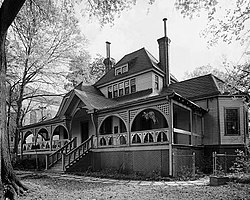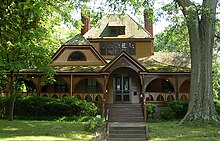Joel Chandler Harris House
Joel Chandler Harris | |
U.S. National Historic Landmark | |
 HABS photo from 1985 | |
33°44′16″N 84°25′20″W / 33.73764°N 84.42219°W / 33.73764; -84.42219 | |
| Area | 3 acres (1.2 ha)[1] |
|---|---|
| Built | 1870 |
| Architectural style | Late Victorian |
| NRHP reference No. | 66000281 |
| Significant dates | |
| Added to NRHP | October 15, 1966[2] |
| Designated NHL | December 19, 1962[3] |
| Designated ALB | October 14, 1989 |
Joel Chandler Harris House, also known as The Wren's Nest or Snap Bean Farm, is a Queen Anne style house at 1050 Ralph D. Abernathy Blvd. (formerly Gordon Street.), SW.[3][2] in Atlanta, Georgia. Built in 1870, it was home to Joel Chandler Harris, editor of the Atlanta Constitution and author of the Uncle Remus Tales, from 1881 until his death in 1908.[3][4]
The house was designated a National Historic Landmark in 1962 for its association with Harris, and is also designated as a historic building by the City of Atlanta. It is now a historic house museum.
Overview
The house was built circa 1868 in an area then known for its upper-class residents. Harris began renting the home in 1881 before buying it two years later thanks to earnings from his first book Uncle Remus: Songs and Sayings. He lived here until his death in 1908.[5] Harris had the home extended with six additional rooms and a new Queen Anne-style facade added in 1884. A furnace, indoor plumbing, and electricity were added circa 1900.[6]
In the late 1880s and early 1890s, Harris's goddaughter, Daisy Baker, who would become Margaret Dumont, lived at Snap Bean Farm.[7]
Harris originally referred to the home as Snap Bean Farm, as a reference to fellow author Eugene Field's home Sabine Farm. The name "Wren's Nest" came from his discovery of a family of wrens living in the mailbox in the spring of 1895.[5]
After several years of correspondence, Indiana poet James Whitcomb Riley visited Harris at Wren's Nest in 1900. Harris's children were especially interested in Riley and nicknamed him Uncle Jeems.[6]
Ultimately, Harris wrote more than twenty books while living in the home as well as several editorials for the Atlanta Constitution and various articles for magazines and newspapers — including his own, The Uncle Remus Home Magazine.[8]
Modern history

After Harris's death, businessman Andrew Carnegie donated $5,000 toward establishing the home as a museum. He had met Harris there in 1900 during a 20-minute visit.[6] From 1913 to 1953, the home was managed by the Uncle Remus Memorial Association, a group of volunteers who operated the house as a museum. In 1983, the organization became known as the Joel Chandler Harris Association.[8]
The home still contains furnishings owned by Harris and utilizes the original paint colors. The house became known as Wren's Nest in 1900 after the Harris children found a wren had built a nest in the mail box; the family built a new mailbox in order to leave the nest undisturbed. The structure was designated a National Historic Landmark in 1962.[1][3][9] The original mailbox that housed the family of wrens and led to the home's name was recreated during a renovation in 1991.[6]
The organization that maintains the Wren's Nest offers tours and regular storytelling. The organization also has two writing programs for Atlanta area youth: KIPP Scribes, in partnership with APS charter school KIPP STRIVE Academy, and Wren's Nest Publishing Company, an entirely high school student run literary journal.[10]
See also
- List of National Historic Landmarks in Georgia (U.S. state)
- National Register of Historic Places listings in Fulton County, Georgia
References
- ^ a b Blanche Higgins Schroer (May 15, 1975) National Register of Historic Places Inventory-Nomination: Joel Chandler Harris House / The Wren's Nest; Snap Bean Farm, National Park Service and Accompanying one photo, front porch, from 1975
- ^ a b "National Register Information System". National Register of Historic Places. National Park Service. January 23, 2007.
- ^ a b c d "Joel Chandler Harris House". National Historic Landmark summary listing. National Park Service. Archived from the original on January 31, 2009. Retrieved April 29, 2008.
- ^ "New Georgia Encyclopedia". Archived from the original on May 31, 2013. Retrieved July 15, 2008.
- ^ a b Burke, Michelle Prater. The Ideals Guide to Literary Places in the U.S. Nashville, TN: Ideals Publications Incorporated, 1998: 80. ISBN 0-8249-4093-8
- ^ a b c d Burke, Michelle Prater. The Ideals Guide to Literary Places in the U.S. Nashville, TN: Ideals Publications Incorporated, 1998: 81. ISBN 0-8249-4093-8
- ^ Marget Dumont! You Know, From the Marx Brothers. Wren's Nest https://wrensnest.org/margaret-dumont-you-know-from-the-marx-brothers/. Retrieved June 6, 2020.
{{cite web}}: Missing or empty|title=(help) - ^ a b Burke, Michelle Prater. The Ideals Guide to Literary Places in the U.S. Nashville, TN: Ideals Publications Incorporated, 1998: 82. ISBN 0-8249-4093-8
- ^ "Joel Chandler Harris Home". National Park Service. Retrieved July 1, 2007.
- ^ Doty, Cate (July 1, 2007). "Rehabilitating Uncle Remus (and His House in Atlanta)". New York Times. Retrieved July 1, 2007.
External links
 Media related to Joel Chandler Harris House at Wikimedia Commons
Media related to Joel Chandler Harris House at Wikimedia Commons
- Official website
- Historic American Buildings Survey (HABS) No. GA-2182, "Joel Chandler Harris House, 1050 Gordon Street, Atlanta, Fulton County, GA", 12 photos, 2 data pages, 1 photo caption page
- Atlanta, Georgia, a National Park Service Discover Our Shared Heritage Travel Itinerary
- The Wren's Nest historical marker
- Original Gas Street Light historical marker at the Wren's Nest
- v
- t
- e
- List of U.S. National Historic Landmarks by state:
- Alabama
- Alaska
- Arizona
- Arkansas
- California
- Colorado
- Connecticut
- Delaware
- Florida
- Georgia
- Hawaii
- Idaho
- Illinois
- Indiana
- Iowa
- Kansas
- Kentucky
- Louisiana
- Maine
- Maryland
- Massachusetts
- Michigan
- Minnesota
- Mississippi
- Missouri
- Montana
- Nebraska
- Nevada
- New Hampshire
- New Jersey
- New Mexico
- New York
- North Carolina
- North Dakota
- Ohio
- Oklahoma
- Oregon
- Pennsylvania
- Rhode Island
- South Carolina
- South Dakota
- Tennessee
- Texas
- Utah
- Vermont
- Virginia
- Washington
- West Virginia
- Wisconsin
- Wyoming
National Register of Historic Places portal
 Category
Category












 Joel_Chandler_Harris_Home
Joel_Chandler_Harris_Home